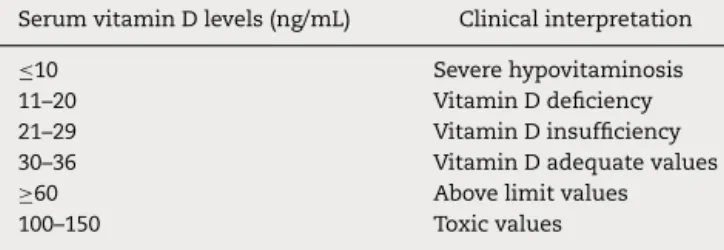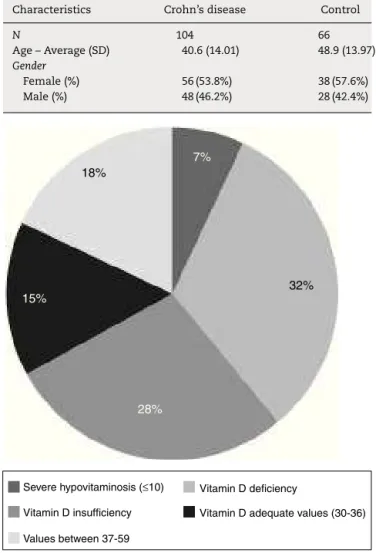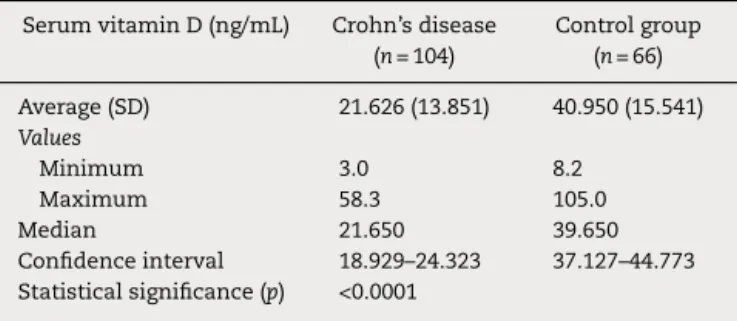w w w . j c o l . o r g . b r
Journal
of
Coloproctology
Original
Article
Hypovitaminosis
D
in
patients
with
Crohn’s
disease
夽
Priscilla
Clímaco
Rebouc¸as
∗,
João
Gomes
Netinho,
Geni
Satomi
Cunrath,
Luiz
Sergio
Ronchi,
Marcelo
Maia
Caixeta
de
Melo,
Francisco
de
Assis
Gonc¸alves
Filho,
Rafaela
Cristina
Coelho
Muniz,
Alissonn
Teixeira
Silva
Martins,
Rafael
Andrade
de
Oliveira,
Ricardo
Mendonc¸a
Costa
Junior
ColoproctologyDiscipline,HospitaldeBase,FaculdadedeMedicinadeSãoJosédoRioPreto(FAMERP),SãoJosédoRioPreto,SP,Brazil
a
r
t
i
c
l
e
i
n
f
o
Articlehistory:
Received11March2016 Accepted25March2016 Availableonline13April2016
Keywords:
Crohn’sdisease
Inflammatoryboweldisease SerumvitaminD
25(OH)D
a
b
s
t
r
a
c
t
Objective:VitaminDhasbeenwidelystudiedasamediatoroftheimmuneresponse, becom-ingevidenttheprevalenceofhypovitaminosisDinpatientswithCrohn’sdisease.Thiswork aimsatevaluatingtheserumlevelsofvitaminDinpatientssufferingfromCrohn’sdisease inasoutheastregionofBrazil.
Methods:Itisaprospectivestudy,withstatisticalanalysisofthevaluesofserumvitamin DmeasuredbetweenApril2014andApril2015inpatientswithCrohn’sdisease. Individ-ualswithmildanalcomplaints,withoutanycolorectalinvolvement,comprisedthecontrol group.
Results:One hundred andfourpatients whoseaverage agewas40.6years were evalu-ated,being56(53.8%)femaleand48(46.2%)male.TheaverageserumvitaminDlevelwas 21.6ng/mL,withstandarddeviation13.85.Thecontrolgroupwascomprisedby66 indi-viduals,whoseaverageagewas48.9years.With38(57.6%)femaleand28(42.4%)male.In thisgrouptheaverageserumvitaminDlevelwas40.9ng/mL.Statisticalsignificancewas demonstratedwithp<0.0001.
Conclusion: TherewashighprevalenceofhypovitaminosisDinpatientswithChron’s dis-ease,whencomparedtothecontrolgroup.HypovitaminosisDwasnotevidencedinpatients inthelattergroup.
©2016SociedadeBrasileiradeColoproctologia.PublishedbyElsevierEditoraLtda.This isanopenaccessarticleundertheCCBY-NC-NDlicense (http://creativecommons.org/licenses/by-nc-nd/4.0/).
夽
Partofthisstudywaspresentedas“OralPresentationintheBrazilianCongressofColoproctology”,inSeptember2014atBrasília,DF, Brazil;andinSeptember2015atRiodeJaneiro,RJ,Brazil.
∗ Correspondingauthor.
E-mails:proctologia@hospitaldebase.com.br,priscillacreboucas@gmail.com(P.C.Rebouc¸as). http://dx.doi.org/10.1016/j.jcol.2016.03.001
Hipovitaminose
D
em
pacientes
portadores
da
doenc¸a
de
Crohn
Palavras-chave:
Doenc¸adeCrohn
Doenc¸ainflamatóriaintestinal VitaminaDsérica
25(OH)D
r
e
s
u
m
o
Objetivo:AvitaminaDtemsidoamplamenteestudadacomomediadoradarespostaimune, tornando-se evidentea prevalência dehipovitaminoseDem pacientescomdoenc¸ade Crohn.EstetrabalhoobjetivaavaliarosníveisséricosdevitaminaDnospacientescom portadoresdedoenc¸adeCrohnemumaregiãodosudestedoBrasil.
Métodos: Trata-sedeestudoprospectivo,comanáliseestatísticadosvaloresdavitamina DséricadosadosentreAbrilde2014eAbrilde2015empacientescomdoenc¸adeCrohn. Indivíduoscomqueixasanaisleves,semqualqueracometimentocolorretal,compuseram ogrupocontrole.
Resultados: Foramavaliados104pacientes,cujamédiadeidadefoide40,6anos,sendo56 (53,8%)mulherese48(46,2%)homens.OnívelséricodevitaminaDmédiofoi21,6ng/mL, comdesvio-padrãode13,85.Ogrupocontrolefoicompostopor66indivíduos,cujamédia deidadefoi48,9anos,com38(57,6%)mulherese28(42,4%)homens.Nestegrupoonível séricomédiodevitaminaDfoi40,9ng/mL.Foidemonstradasignificânciaestatísticacom p<0,0001.
Conclusão: HouveelevadaprevalênciadehipovitaminoseDempacientescomdoenc¸ade Crohn,quandocomparadosaogrupocontrole.NãofoievidenciadahipovitaminoseDentre ospacientesdesteúltimogrupo.
©2016SociedadeBrasileiradeColoproctologia.PublicadoporElsevierEditoraLtda.Este éumartigoOpenAccesssobalicençadeCCBY-NC-ND (http://creativecommons.org/licenses/by-nc-nd/4.0/).
Introduction
Crohn’sdiseaseisanintestinalinflammatorydisease char-acterizedbychronicintestinalinflammationofautoimmune characteranduncertainetiology.1–7However,thereisproven
importance of the interaction between genetic and envi-ronmentalfactors inthe triggeringofthe aberrant cellular immune response through Th1, Th17 cells and their pro inflammatorycytokines.1–3,7–11
Inthecontextofcellularimmunity,the discoveryofthe presenceofvitaminDreceptor(VDR)inthemacrophagesand lymphocytes,hasopenedanewpathforresearchconcerning autoimmunediseases.1–3,7–13
VitaminDisasteroidhormonederivedfromcholesterol, obtained,mainlythroughsolarexpositiontobeta-ultraviolet rays.1,7–12 However, there is also a small acquisition from
dietaryintake.1,7–9,11 Thissteroidismetabolizedintheliver
and subsequently in the epithelium of the renal proximal tubeinitsactiveform,thecalcitriol(1,25OH2D).Ithasbeen
evidencedthattheserumvitaminD,inmostpartofit(85–90%) carriedbythevitaminDcarrierprotein(DCP),hasa signif-icant role in the cellular immune response.1 By diffusion,
thevitaminDentersinthedefensecellsandisactivatedby 1␣-hydroxylasein1.25(OH)2D3 (VitaminD3)and1.25(OH)2D
(Vitamin D2).1 They form a complex when linked to the
vitaminD receptorwhich activates the gene transcription, which act on the cellular immune response through the inhibition of T cells.1,3,9–11 Suppressed, the Th1 and Th17
cells,determinethereductionofproductionandrelease of theirpro-inflammatorycytokines,suchasIFN␦,IL2,IL12and
IL17.1,3,9–12
Besidestheinhibitoryeffecttothesecells,the activated DCPcomplex,alsostimulatestheproliferationofT-regulatory
cells(T-reg),regainingthen,thegastrointestinal immunologi-calhomeostasis.1,3,9–11
When evaluated the role ofvitaminD ininnate immu-nity, it hasbeen foundthatthe activation ofthereceptors ofthemembranetool-likereceptors(TLR)ofmacrophageby intestinalbacteriaresultintheconversionand bioavailabil-ityofactivevitaminD,besidestheincreaseoftheexpression ofDCPandantimicrobianpeptides,suchascathelicidinsand defensins.1,3,9,11
TheclassificationofserumvitaminDconcentrationranges fromseveredeficiencytotoxiclevels,accordingtoreference values,asdemonstratedinTable1.1,2,8
Several studies have demonstrated the prevalence of hypovitaminosis D in patients suffering from Crohn’s disease.2,4–6,8,14–17Inthiscontext,data,stilluncertain,show
interferenceofserumvitaminDlowlevelsintheappearance andprogressionofthedisease.2,3,9–11,18,19
Aiming atcarrying out datasurveying, asthe first step towardtheinvestigationoftherelationshipbetweenvitamin D and Crohn’s disease in the scenario of southern tropi-calcountries,beingableto,inthefuture,cooperateforthe
Table1–ClinicalinterpretationofserumvitaminD levels.1–3
SerumvitaminDlevels(ng/mL) Clinicalinterpretation
≤10 Severehypovitaminosis
11–20 VitaminDdeficiency
21–29 VitaminDinsufficiency
30–36 VitaminDadequatevalues
≥60 Abovelimitvalues
developingofnewtoolstoevaluatediseaseactivityandeven thetreatmentoptimization,thisstudyhasasaimtoevaluate serumvitaminDlevelsinpatientssufferingfromCrohn’s dis-easefollowedbytheDisciplineofColoproctologyofHospital deBaseinSãoJosédoRioPreto/SP(FAMERP),comparingthem toacontrolgroup.
Methods
Itisaboutatransversalstudy,carriedoutinSãoJosédoRio Preto,acitylocatedinthesoutheastregionofBrazil,latitude 20◦49′11′′South,489mabovethesealevel.
Patients suffering from Crohn’s disease were identified, withclinical,endoscopicalandhistopatologicaldiagnosis, fol-lowedbytheColoproctologydisciplineofHospitaldeBasede SãoJosédoRioPreto/SP,oftheMedicalSchoolofSãoJosédo RioPreto,andafterwards,madeadatabasewiththeserum vitaminD valuesdosedbetweenApril2014and April2015, theirageandgender.Similardata,inthesameperiod,were collected fromindividuals withmildanal complaints, with nocolorectalinvolvement,alsoassistedbythesamemedical team,comprisingthus,thecontrolgroup.
SerumvitaminD dosagewascarriedout bylaboratorial exams,requestedduringthepatients’followupinthe out-patientclinic.AlltheexamswerecarriedoutbytheCentral LaboratoryofHospital de Baseof SãoJosé do RioPreto/SP throughelectrochemiluminescense,consideringinsufficient levelsofvitaminD,valueslowerthan30ng/mL,accordingto datafromtheUSNationalKidneyFoundation.
Thedataweresubmittedtodescriptivestatistical analy-sis,withvaluesofmedia,medianandstandarddeviation,and comparativeanalysisthroughMann–Whitneynon-parametric test, being considered statistical significance for values of
p>0.05.
Ethicalconsiderations
The study was approved by the Research Ethics Commit-tee ofthe MedicalSchool of São José do Rio Preto (CAAE: 31070614.7.0000.5415), and informed written consent was obtainedfromeachsubjectbeforeenteringthestudy.
Results
OnehundredandfourpatientssufferingfromCrohn’sdisease wereevaluated,whoseaverageagewas40.6years(SD14.01), rangingfrom15to75years,being56(53.8%)femaleand48 (46.2%)male.Amongtheindividualsthatcomprisedthe con-trolgroup,inatotalof66,theaverageagewas48.9years(SD 13.97),rangingfrom15to79years,being38(57.6%)femaleand 28(42.4%)male(Table2).
TheaverageserumvitaminDlevelamongpatientswith CD, was 21.6ng/mL, with SD of 13.85, ranging from 3.0 to 58.3ng/mL.Fiftynine patientswere identifiedwith hypovi-taminosis D, representing 66.3%. From these, seven (6.7%) presentedserumvitaminDvalueslowerorequal10ng/mL, thirtythree(31.7%)between11and20ng/mLandtwentynine (27.9%)between21and29ng/mL.Only16(15.4%)presented
Table2–Characteristicsofgroupsconcerningageand gender.
Characteristics Crohn’sdisease Control
N 104 66
Age–Average(SD) 40.6(14.01) 48.9(13.97) Gender
Female(%) 56(53.8%) 38(57.6%)
Male(%) 48(46.2%) 28(42.4%)
18%
7%
32%
28% 15%
Severe hypovitaminosis (≤10) Vitamin D deficiency
Vitamin D insufficiency Vitamin D adequate values (30-36)
Values between 37-59
Fig.1–SerumvitaminDlevelsinpatientswithCrohn’s disease.
serumvitaminDvaluewithinadequatevalues,between30 and36ng/mL(Fig.1).
Amongthecontrolgroup’sindividuals,theserumvitamin Dlevelwas40.9ng/mL,withSDof15.54.SerumvitaminD val-uesconsideredadequateorabovenormalitywerepresented by52patients(78.8%).
Accordingtothecomparativeanalysisbetweenserum vita-minDvaluesofbothgroups,throughtheMann–Whitneytest,
pvaluewaslowerthan0.0001(Table3).
Discussion
Epidemiologically, the literature data corroborate with the present study. The literature shows bimodal incidence of Crohn’sdiseaseinrelationtoage,affectingindividualsfrom 15to40years,andfrom 50to80years.2,4,5,8,14,17,20Thereis
also,agreementontheinvolvementbetweengender,witha higherpercentageofwomen.2,8,14,17 DeBruynet al.8
Table3–ComparativeanalysisofserumvitaminD levelsbetweengroups.
SerumvitaminD(ng/mL) Crohn’sdisease (n=104)
Controlgroup (n=66)
Average(SD) 21.626(13.851) 40.950(15.541) Values
Minimum 3.0 8.2
Maximum 58.3 105.0
Median 21.650 39.650
Confidenceinterval 18.929–24.323 37.127–44.773 Statisticalsignificance(p) <0.0001
Ananthakrishnanetal.17andAzzopardietal.20The
charac-teristicsbetweengroups,patientswithCrohn’sdiseaseand controlgroupweresimilar.
TheserumvitaminDleveldosingofpatientswithCrohn’s disease corroborated the findings of the great majority of studiesalready published,demonstratingtheprevalenceof hypovitaminosisD.TheaverageserumvitaminDamongthe patientswithCrohn’sdisease ranged,intheliteraturefrom 13.1 to27ng/mL2,4–6,8,14,17 Yet, the controlgroup presented
serumvitaminDlevelsconsideredadequate.
Thecomparativeanalysis betweenthe patientsand the controlgroupdemonstrated high statistical significance,in agreementwithdatapresentedintheliterature.Studieswith suchemphasishavebeendisclosed,mainly,from2013, how-everuptonowtherehavenotbeendataconcerningcountries withatropicalclimateinthesouthernhemisphere.
The hypovitaminosis D is common in high latitude regions.1,2,4,5,8,18,20 Brazil is located in a low latitude area
inthe southern hemisphere, close tothe tropics, showing favorablegeographicpositionandhighincidenceof ultravi-oletradiation.However,the present studyobtainedsimilar resultstothosefoundincountrieslocatedinhighlatitudes, demonstrating,thus,the presenceofhypovitaminosisD in patients sufferingfrom Crohn’sdisease,contrary toserum levelspresentedbythecontrolgroup,beingthem,thevery representativesofthecountry’sgeographicposition.DeBruyn etal.8study,carriedoutinHoland,showedthepresenceof
hypovitaminosis D among patients suffering from Crohn’s disease,aswell asDumitrescu et al.4 study,carried out in
Romenia.
TheserumvitaminDdosingofthisstudy,forbothgroups, tookplaceduringawholeyear,involvingalltheseasonsof the year,different levelsofUV raysincidence and degrees ofsolarexposition,however,abettercontrolof homogene-ityinthecollectingmustbedoneinordertoreducepossible biases. A study published by Raftery et al.19 shows
rela-tionshipbetweenvitaminDand activityofCrohn’sdisease irrespectivelyofthe season ofthe year.Therefore, hypovi-taminosisD haspresenteditselfprevalent inthis groupof patients,irrespectivelyoftheregionoftheworldortimeofthe year.
Conclusion
Inconclusion,theprevalenceoflowserumvitaminDlevels hasbeenevidenced amongpatients sufferingfrom Crohn’s
disease followedbythe serviceofColoproctologyof Hospi-taldeBaseinSãoJosédoRioPreto/SP,whencomparedtoa controlgroup,groupwhichpresentedserumlevelsconsidered satisfactory.
Theissue,however,stillneedsmorecomprehensive stud-ies, mainly those who aim at evaluating serum vitamin D values related to clinical treatment and also the effects of vitamin D supplementation in the activity of the dis-ease and healing of the mucous membrane. Thus, it will possibletoevaluateinarelevantway,the vitaminD repo-sition in the Crohn’s disease remission, optimizing these patients´treatmentandcorroboratingfortheimprovementof theirqualityoflife.
Conflicts
of
interest
Theauthorsdeclarenoconflictsofinterest.
r
e
f
e
r
e
n
c
e
s
1.BassonA.VitaminD.Crohn’sdiseaseintheadultpatient:a review.JParenterEnteralNutr.2014;38:438–58.
2.HassanV,HassanS,Seyed-JavadP.Associationbetween Serum25(OH)vitaminDconcentrationsandinflammatory boweldiseases(IBDs)activity.MedJMalaysia.2013;68:34–8. 3.XuXR,LiuCQ,FengBS.Dysregulationofmucosalimmune
responseinpathogenesisofinflammatoryboweldisease. WorldJGastroenterol.2014;20:3255–64.
4.DumitrescuG,MihaiC,DrangaM.Serum25-hydroxyvitamin Dconcentrationsandinflammatoryboweldisease
characteristicsinRomania.WorldJGastroenterol. 2014;20:2392–6.
5.TanB,LiP,LvH.VitaminDlevelsandbonemetabolismin Chineseadultpatientswithinflammatoryboweldisease.J DigDis.2014;15:116–23.
6.VeitLE,MarandaL,FongJ.ThevitaminDstatusin inflammatoryboweldisease.PLoSONE.2014;9(7):e101583. 7.RafteryT,O’MorainCA,O’SullivanM.VitaminD:newroles
andtherapeuticpotentialininflammatoryboweldisease. CurrDrugMetab.2012;13:1294–302.
8.deBruynJR,VanHeeckerenR,PonsioenCY.VitaminD deficiencyinCrohn’sdiseaseandhealthycontrols:a prospectivecase–controlstudyintheNetherlands.JCrohns Colitis.2014;8:1267–73.
9.CantornaMT,WaddellA.ThevitaminDreceptorturnsoff chronicallyactivatedTcells.AnnNYAcadSci.2014;1317:70–5. 10.AdoriniL,PennaG.Controlofautoimmunediseasesbythe
vitaminDendocrinesystem.NatClinPractRheumatol. 2008;4:404–12.
11.CantornaMT,ZhuY,FroicuM.VitaminDstatus,
1,25-dihydroxyvitaminD3,andtheimmunesystem.AmJClin
Nutr.2004;80:1717S–20S.
12.HongQ,XuJ,XuS.Associationbetweenserum
25-hydroxyvitaminDanddiseaseactivity,inflammatory cytokinesandbonelossinpatientswithrheumatoid arthritis.Rheumatology.2014;53:1994–2001.
13.NiinoM,FukazawaT,MiyazakiY.SuppressionofIL-10 productionbycalcitriolinpatientswithmultiplesclerosis.J
Neuroimmunol.2014;270:86–94.
14.TurkN,TurkZ.PrevalenthypovitaminosisDinCrohn’s diseasecorrelateshighlywithmediatorsof
15.HamM,LonghiMS,LahiffC.VitaminDlevelsinadultswith Crohn’sdiseaseareresponsivetodiseaseactivityand treatment.InflammBowelDis.2014;20:856–60.
16.JantchouP,Clavel-ChapelonF,RacineA.Highresidentialsun exposureisassociatedwithalowriskofincidentCrohn’s diseaseintheprospectiveE3Ncohort.InflammBowelDis. 2014;20:75–81.
17.AnanthakrishnanAN,CaganA,GainerVS.Normalizationof plasma25-hydroxyvitaminDisassociatedwithreducedrisk ofsurgeryinCrohn’sdisease.InflammBowelDis.
2013;19:1921–7.
18.JørgensenSP,HvasCL,AgnholtJ.ActiveCrohn’sdiseaseis associatedwithlowvitaminDlevels.JCrohnsColitis. 2013;7:e407–13.
19.RafteryT,MerrickM,HealyM.VitaminDstatusisassociated withintestinalinflammationasmeasuredbyfecal
calprotectininCrohn’sdiseaseinclinicalremission.DigDis Sci.2015;60:2427–35.


